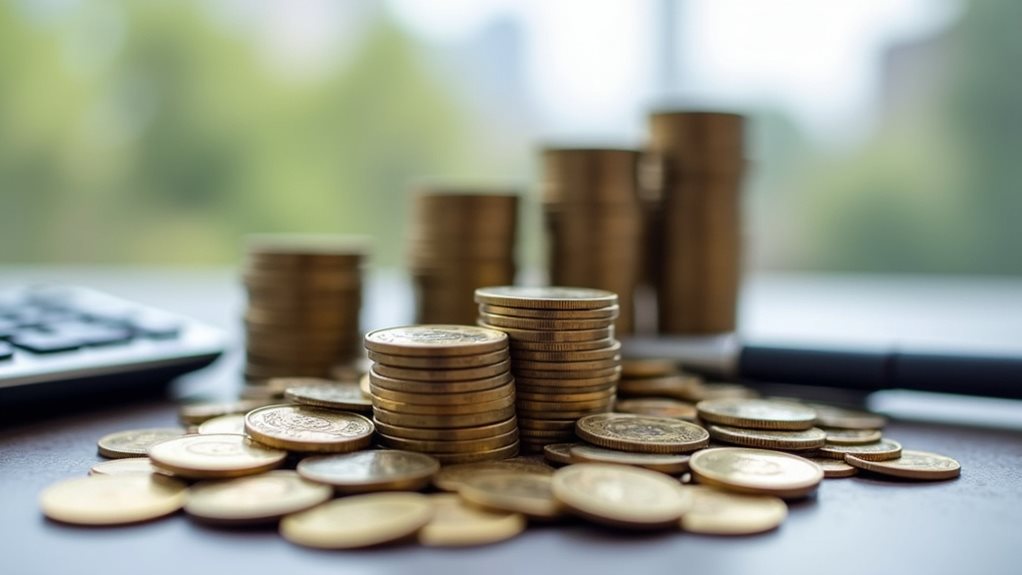APY (Annual Percentage Yield) is the real money-maker in banking – it's what you actually earn on deposits over a year, including compound interest. Unlike simple interest, APY factors in how often the bank pays interest on your interest, which can add up fast. Most savings accounts offer a measly 0.41% APY, while high-yield accounts can hit 4% or higher. The frequency of compounding makes a surprising difference in the final numbers.

Money talks, but APY speaks volumes in the banking world. APY, or Annual Percentage Yield, tells you exactly how much interest your money earns over a year when you factor in compound interest. It's not just simple interest – we're talking about interest on interest. Yeah, your money actually makes babies, and those babies make more babies. That's what compound interest does.
Making your money work harder isn't just about interest – it's about compound interest turning your dollars into money-making machines.
Let's get real about the numbers. Right now, the national average APY for savings accounts is a measly 0.41%. Pathetic, right? But here's where it gets interesting: high-yield savings accounts are offering around 4% APY. That's nearly ten times more. The math isn't rocket science, but it matters. With compound interest, your money grows faster than a teenager's appetite. Money market accounts can earn up to 4.20% APY depending on the bank.
The frequency of compounding makes a difference too. Daily, monthly, annual – each has its own impact. More frequent compounding equals more money, period. Banks use this fancy formula: APY = (1 + r/n)^n – 1. Sound complicated? Don't sweat it. Banks do the math for you, thanks to something called the Truth in Savings Act. They have to. It's the law. When comparing loans or credit cards, remember to look at simple interest rates reflected in APR instead.
Different accounts come with different APY setups. Savings accounts? Their rates bounce around like a rubber ball, changing with market conditions. CDs are the steady Eddie of banking – fixed rates for fixed terms. Money market accounts and some checking accounts offer APYs too, though checking account rates usually aren't anything to write home about. Online banks tend to offer better rates because they don't have to pay for fancy buildings and free coffee in the lobby. High-yield savings accounts and CDs consistently outperform traditional savings options.
Here's something people often mix up: APY versus APR. They're totally different beasts. APY is what you earn on deposits – it's your friend. APR is what you pay on loans – not so friendly. APR includes fees and costs, while APY is purely about earning potential. Think of APY as the good cop and APR as the bad cop of banking terms.
The banking world loves its jargon, but APY is actually pretty straightforward. It's the real deal when it comes to showing how much your money can grow. No smoke, no mirrors – just cold, hard math showing exactly what your money's doing while you sleep.
And let's face it, who doesn't like making money while they sleep?
Frequently Asked Questions
How Often Does APY Get Compounded in Different Types of Bank Accounts?
Bank account compounding varies wildly.
High-yield savings accounts usually compound daily – they're show-offs like that.
Regular savings and checking accounts? Monthly, typically.
CDs often stick to annual compounding, playing it safe and boring.
Money market accounts bounce between daily and monthly, depending on the bank's mood.
Some accounts even do quarterly compounding, because apparently, that's a thing.
Bottom line: more frequent compounding equals more money.
What Factors Can Cause My APY Rate to Change Over Time?
Several key factors can shake up APY rates. The Federal Reserve's decisions are a major player – when they move rates, banks follow suit.
Economic conditions matter too. High inflation? Rates often climb.
Market competition forces banks to duke it out for deposits. Online banks typically offer better rates than traditional ones, thanks to lower overhead costs.
Bank policies and promotional strategies can also trigger changes. It's a complex dance of economics and competition.
Can I Negotiate a Higher APY With My Bank?
Banks don't typically negotiate APY rates with individual customers.
It's just not how it works. APY rates are primarily determined by market conditions and Federal Reserve decisions – not customer sweet-talking.
While customers can't haggle for better rates, they can choose between different banks and account types.
Online banks often offer higher APYs than traditional banks, thanks to lower operational costs.
That's just the reality of modern banking.
Is APY Taxable Income, and How Should I Report It?
Yes, APY earnings are absolutely taxable – Uncle Sam wants his cut.
Interest income must be reported on Form 1040, and banks send out Form 1099-INT for earnings over $10.
But here's the kicker: taxpayers must report ALL interest income, even amounts under $10.
If total interest tops $1,500, Schedule B comes into play.
The tax rate? Whatever tax bracket the person falls into. Plain and simple.
Which Types of Banks Typically Offer the Highest APY Rates?
Online banks consistently offer the highest APY rates in the banking world.
No fancy lobbies or tellers means lower overhead costs – and they pass those savings to customers.
Credit unions are another top contender, often beating traditional banks with impressive rates.
Some digital-only banks are pushing rates above 4.5% these days.
Traditional brick-and-mortar banks? They typically trail behind, stuck offering lower rates thanks to their expensive physical locations and operational costs.









